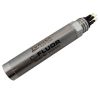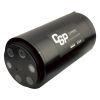Turner Designs C3 Submersible Fluorometer
Features
- Internal memory with lithium battery option for unattended deployments
- Factory-installed temperature sensor with optional depth sensor and mechanical wiper
- Depth rated to 600 meters
- Expedited repair and warranty service
- Lifetime technical support
- More
Overview
The Turner Designs C3 Submersible Fluorometer is designed to incorporate up to three optical sensors ranging from the ultraviolet to the infrared spectrum. Internal memory storage capacity combined with an external submersible lithium ion battery allows the C3 to run during extended or short-term deployments. Each Turner Designs C3 comes with a factory-installed temperature sensor and a depth rating of 600 meters. An optional factory-installed depth sensor and mechanical wiper is also available. The C-Soft Windows based software allows for intuitive calibration, data logging set up, file management capabilities as well as digital or analog data integration.
Benefits
- Order up to Three Optical Sensors
- Digital or Analog Integration with a CTD Profiler or 3rd Party Platform
- Easy to Use C-Soft Software with Data Management Capabilities
- Extended Deployments with Submersible Battery
- Temperature Sensor Included
- Optional Depth Sensor Available
- Optional Mechanical Wiper Available
- Weight in Air: 1.64 kg (3.6 lbs.)
- Length: 23cm (9.1 in.)
- Diameter: 10cm (3.9 in)
- Material: Delrin Plastic
- Temperature: -2 to 50 degrees C
- Depth: 0 to 600 meters
- External Power: 8 to 30 VDC
- Output: Digital Signal
- Interface: RS232 Interface
- Maximum Sample Rate: 1 Second
- Maximum Power Requirements: 1 Watt
- (1) C3 submersible fluorometer
- (1) PC interface cable
- (1) 12V power supply
- (1) Factory-installed temperature sensor
- (1) Communication and integration cable
- (1) "Y" style USB to male and female DB-9
- (1) 8-pin female dummy plug
- (1) CD with software, user's manual, and quick start guide
In The News
Buoy-Based Solutions: Strengthening Kentucky’s Emergency Response Efforts
When Kentucky’s Emergency Response Team (ERT) has to act quickly in response to chemical and oil spills in the Commonwealth, they rely on small, easily deployable buoys to collect critical data that help minimize and evaluate damages in environmental emergencies. With a background in geology, Robert Blair primarily worked with groundwater and got involved sporadically with the ERT during groundwater contamination emergencies. Over time, this involvement led to him joining the ERT as an On-Scene Coordinator and then becoming the branch manager for the team and overall Emergency Response Branch .
Read MoreThree Decades of Research at Acton Lake
A multi-disciplinary team at Miami University, Ohio, has been studying the environmental change at Acton Lake for over three decades. Using three different NexSens buoys over this time, the team has an incredible archive of data that is helping build a picture of Acton’s past, present, and future. Until recently, a NexSens CB-50 buoy was used alongside other environmental monitoring at Acton Lake. In May 2025, the Miami team deployed a new XB-200 buoy , future-proofing their ongoing monitoring using real-time buoy systems. Acton Lake, a small hypereutrophic reservoir in southwest Ohio, covers 2.4km² and has a maximum depth of about 8m. The dam was built in 1956, and the lake has a large agricultural watershed.
Read MoreSource Water Monitoring in Albany, New York: Tracing Water Quality throughout Tributaries
Thousands of US cities pull their drinking water from natural source waters like reservoirs, rivers, and streams, making overall watershed health a key consideration for water providers. In Albany, New York, the Albany Department of Water and Water Supply delivers drinking water to over 100,000 residents as well as monitors and manages the larger drinking water supply watershed. Hannah Doherty, Environmental Specialist at the Albany Department of Water and Water Supply , spends her days working with a small team to monitor the drinking supply and the connected water bodies. Doherty explains, “We’re the first to encounter the water that ends up being the drinking water.
Read More

































